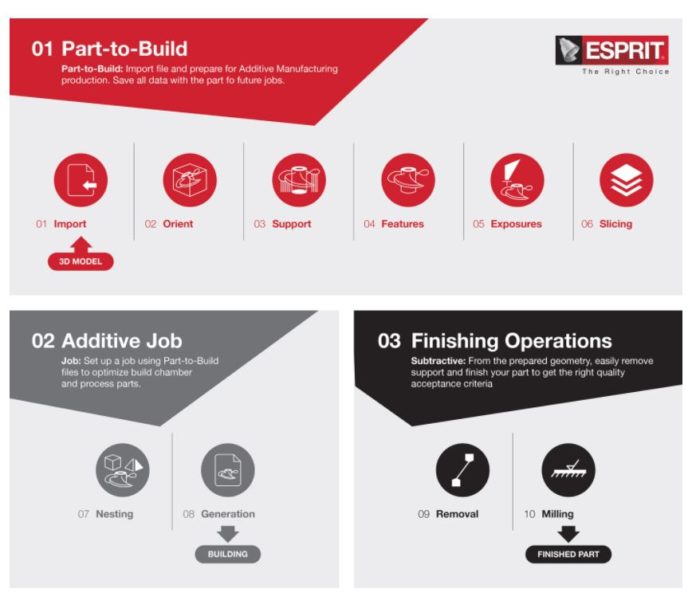Hexagon’s Manufacturing Intelligence division has recently introduced a new software tool that helps engineers prepare 3D printed components for production with powder-bed fusion technologies. The Computer-aided-manufacturing (CAM) software comes to respond to challenges raised by manufacturing operations that involve both additive and subtractive processes within the same platform.
For engineers who would like to have build preparation and programming within the same software tool, it has now been allowed with ESPRIT CAM software.
Today, PBF is the most mature additive manufacturing technology for industrial production and represents 86 percent of the worldwide machine install base*. PBF is used to build 3D parts by heating successive layers of powder, typically at the micron-level, and generally produces parts that require finishing with conventional CNC machine tools to achieve a high-quality surface finish.
Hexagon’s ESPRIT CAM software now offers a build preparation workflow within the CAM environment to provide a single, streamlined platform for both the additive build and finishing operations. Its patented Part-to-Build™ workflow was developed to change the prevailing 3D-printing paradigm from the preparation of rapid prototypes to industrialisation with a true CAM experience that includes build-preparation steps and the programming tools for post-processing printed parts with wire electrical discharge machining (EDM) and milling machine tools. In series production, a given part will be produced hundreds of times with the same build plates, orientation, support structure generation, and exposure strategy assignment. The Part-to-Build workflow addresses part preparation and job preparation with dedicated functionality within one piece of software, making manufacturing smarter by enabling volume efficiencies and automating repetitive tasks, such as slicing.
Designed for CAM programmers, ESPRIT CAM’s build preparation employs a workflow based on parametric data that ensures high accuracy and adherence to the geometry of the original computer-aided design (CAD) model until it is sliced in preparation for 3D printing. The software reads and manipulates all popular parametric CAD formats and automatically identifies those surfaces that require support. The software also assists with the creation of support structures, generating parametric surfaces with teeth, fragmentation, and perforation. Support generation can be automated for future builds by assigning a pre-set to a region in the surface, capturing valuable production know-how and improving future productivity. Because the majority of models for 3D-printed parts are STL-based, ESPRIT CAM also provides an STL (mesh) slicer that leverages a built-in software kernel.
Once a part is sliced, it can be imported to the software’s job preparation environment and re-used whenever needed. Here, exposure strategies are automatically assigned according to the chosen machine set-up. As the part is already sliced, the programmer need only nest them and the corresponding machine file is generated based on the target machine set-up. Hexagon enjoys close collaboration with machine manufacturers, providing factory-certified machine files for optimal performance and confidence, and partners with world-leading additive research institutions to continuously apply the latest cutting-edge technologies.
“Combining build preparation in the CAM environment is the first step on the journey to true computer-aided manufacturing using additive methods, enabling higher levels of automation and productivity,” says Clement Girard, product manager for additive manufacturing and artificial intelligence at Hexagon. “Our goal is to make the programmer’s life easier, thereby making the shop floor more productive and future-ready to apply the best available machinery and processes to the part in hand.”
By using ESPRIT Additive PBF in conjunction with other Hexagon products, such as MSC Apex Generative Design and Simufact Additive, customers can further optimise their part designs for additive manufacturing.
Remember, you can post job opportunities in the AM Industry on 3D ADEPT Media free of charge or look for a job via our job board. Make sure to follow us on our social networks and subscribe to our weekly newsletter : Facebook, Twitter, LinkedIn & Instagram ! If you want to be featured in the next issue of our digital magazine or if you hear a story that needs to be heard, make sure to send it to contact@3dadept.com






